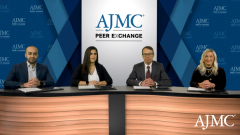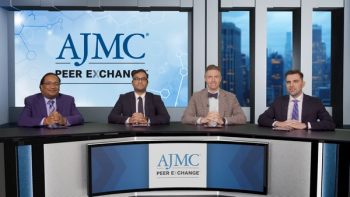
Financial Considerations in RRMM Treatment Landscape
In their closing thoughts, the panelists discuss financial considerations for treating patients with RRMM.
Episodes in this series

Jeffrey Matous, MD: Let’s tackle finances and talk about the financial considerations we have using T-cell-redirecting therapies. What are the challenges? What’s out there? Zahra, lead us off.
Zahra Mahmoudjafari, PharmD, MBA, BCOP, FHOPA: If I had a wish list of things I want to say to my payer colleagues, it would say to bear with us while we figure out sequencing, length of therapy, and therapy options. We try to tailor and do an individualized approach for patients receiving care for multiple myeloma. The data are quickly evolving. In the future we might see additional CAR [chimeric antigen receptor] T-cell infusions, which gets a little nervous because of the cost and toxicities. But it’s reasonable to say that in the span of a treatment course for a patient, you’ll likely see them receive both CAR-T cell therapy and bispecifics. The sequence is inconsequential. They may do it multiple times. We have a lot left to learn. But if I had a wish list, I’d ask the public to bear with us while we figure it out.
Jeffrey Matous, MD: PharmDs have their fingers on the pulse of finances way better than we do. We’ll give everything we can all the time. Kirollos, what about you? How are you going to interact with your payers? Payers are aware that we have these phenomenal but superexpensive therapies.
Kirollos Hanna, PharmD, BCPS, BCOP, FACCC: It goes back to 1 of the points I mentioned. But something that we all need to understand and realize is that the reason a lot of individuals are trying to transition to the outpatient setting is the reimbursement model. We’re giving these CAR T-cell therapies in the hospital, and we’re underwater. We’re not getting reimbursed. If the patient has complications or has to get hospitalized if you’re doing an outpatient immediately, there are many complexities around that. How systems could be impacted by the financials of CAR T-cell therapies also limits some of the utility based on the financial implication. It’s not about whether I can do 1 or 2 a week. It’s about doing it feasibly from a financial perspective.
With teclistamab and the bispecifics, a portion of therapy is going to be given in the inpatient. A lot of times we’re underwater there. But there could be profit margins in the outpatient settings. That goes back to my point earlier. We all want to tell pharma and payers that we need to reduce the cost of care. But all of that is going to be encompassed through sequencing data, HEOR [health economics and outcomes research] data, coming together and trying to understand the different reimbursement models, and figuring out supportive care strategies and measures. That would help us reduce the total cost of care for these patients.
Jeffrey Matous, MD: What’s the clinician perspective?
Beth Faiman, PhD, MPN, APN-BC: Myeloma is an incurable cancer. It’s a cancer of the plasma cells that fight infection, which is a long-term complication. It’s still the No. 1 cause of death. You’re going to see hospitalizations from infections if you don’t have them on IVIg [intravenous immunoglobulin], antibiotics, and antivirals and surveil for them. Understanding supportive care drugs is critical. And they’re going to need more than 1. We’ll try to funnel them toward clinical trials so we can gather information on the best course of sequencing, the best drug for the best patient. We all want that. But it takes time. We’ll do clinical trials, but we’re going to have to do a CAR T, a bispecific, and maybe another 1 from another target. Then we’ll go back to some daratumumab and isatuximab. We forgot about that.
Jeffrey Matous, MD: Let’s wrap things up. Let’s start at the end with final thoughts about our fun and fruitful discussion.
Kirollos Hanna, PharmD, BCPS, BCOP, FACCC: We learned quite a bit from one other and the different practices at our institutions. But we were also able to highlight the exciting pipeline of myeloma, where we are with myeloma, and the unknown that we’re heading into with myeloma and how things are going to pan out. We’ve transitioned from 3-drug regimens, like VRd [bortezomib, lenalidomide, dexamethasone] and CyBorD [cyclophosphamide, bortezomib, dexamethasone], to where we are today. As these clinical trials pan out, we’re going to see things move to earlier lines, which sets the stage for the fourth and fifth lines and with newer and novel targets like the ones we discussed.
Zahra Mahmoudjafari, PharmD, MBA, BCOP, FHOPA: If I was going to use 1 word, it would be optimistic. The future of multiple myeloma therapy and the management of these patients is full of hope and potential. We’ve made a lot of great strides, and we have a long way to go. I’m excited to see where this goes.
Jeffrey Matous, MD: Beth?
Beth Faiman, PhD, MPN, APN-BC: I was excited with the 2-drug regimen, thalidomide and dexamethasone, when that was out.
Jeffrey Matous, MD: Absolutely.
Beth Faiman, PhD, MPN, APN-BC: Everybody was saying that thalidomide was expensive, but look at drug costs now. I wish we could bring the cost of drugs down, but we can’t. We’re fortunate in the United States and many areas of Canada to have access to these drugs because Europe and other regions might not have access. We’re trying to gather more information on clinical trials. The future is bright. We didn’t even get to all the other targets. We talked about some. There are too many. The CELMoDs are also very exciting. Not everybody is going to get CAR T or be a candidate for CAR T or bispecifics. We’re still going to need all these other drugs to be available for our patients and in combination. But I’d like to hear from you, Dr Matous.
Jeffrey Matous, MD: I’ll put on my Pollyanna hat. It’s exciting. It’s an amazing time to be involved in myeloma care, to be offering these things to our patients. A few years ago, you would have thought you were out of treatment options for your patient, but today you have them. That happens again and again in myeloma. We’re going to cure a substantial number of patients with myeloma. We’re going to do it by identifying patients at the earliest time, when we think that they’re the right candidate for treatment. It’s going to be a combination of immunotherapy and standard therapies. Therapy of fixed duration is associated with long remissions and an excellent quality of life. That’s not too far in the future for our patients. That’s so exciting.
My colleague Jeff Wolf at UCSF [University of California San Francisco] and I were having a big debate 1 year about curing myeloma. He said, “Stop. Our goal for patients is long survival and excellent quality of life.”We’re close to getting there for our patients. With that, I want to thank all of you for being such phenomenal panelists.
Zahra Mahmoudjafari, PharmD, MBA, BCOP, FHOPA: Thanks for being a great moderator.
Jeffrey Matous, MD: You guys are amazing. Everyone who’s involved in the care of patients with myeloma should have hope. We have such great people at many places looking out for our patients. Thank you very much.To our viewing audience, we hope you found this AJMC® Peer Exchange to be useful and informative.
Transcript edited for clarity.
Newsletter
Stay ahead of policy, cost, and value—subscribe to AJMC for expert insights at the intersection of clinical care and health economics.







